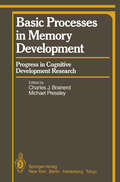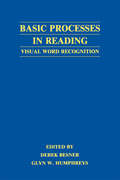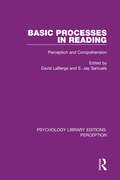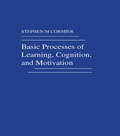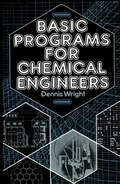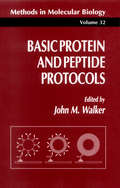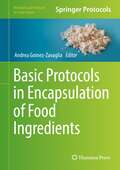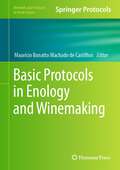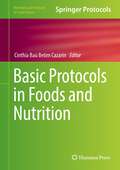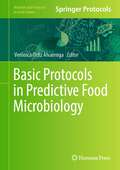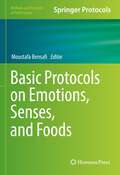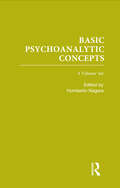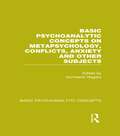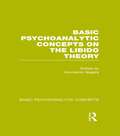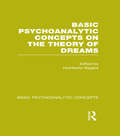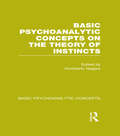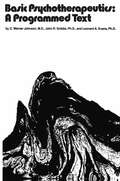- Table View
- List View
Basic Processes in Memory Development: Progress in Cognitive Development Research (Springer Series in Cognitive Development)
by C. J. Brainerd M. PressleyFor some time now, the study of cognitive development has been far and away the most active discipline within developmental psychology. Although there would be much disagreement as to the exact proportion of papers published in developmental journals that could be considered cognitive, 50% seems like a conservative estimate. Hence, a series of scholarly books devoted to work in cognitive development is especially appropriate at this time. The Springer Series in Cognitive Development contains two basic types of books, namely, edited collections of original chapters by several authors, and original volumes written by one author or a small group of authors. The flagship for the Springer Series is a serial publication of the "advances" type, carrying the subtitle Progress in Cognitive Development Research. Each volume in the Progress sequence is strongly thematic, in that it is limited to some well-defined domain of cognitive developmental research (e.g., logical and mathematical development, development of learning). All Progress volumes will be edited collections. Editors of such collections, upon consultation with the Series Editor, may elect to have their books published either as contributions to the Progress sequence or as separate volumes. All books written by one author or a small group of authors are being published as separate volumes within the series.
Basic Processes in Reading: Visual Word Recognition
by Derek Besner Glyn W. HumphreysThe chapters in this new book span the range of reading processes from early visual analysis to semantic influences on word identification, thus providing a state-of-the-art summary of current work and offering important contributions to prospective reading research. Basic Processes in Reading examines both future plans and past accomplishments in the world of word identification research. Three chapters provide a futuristic view taking a parallel distributed processing approach to semantic priming, phonology, and the identification of old words and the learning of new words. Reviews on eye movements in reading and semantic priming on word identification provide a retrospective summary of work on these issues as well as solid pointers for future investigations. Other chapters provide new demonstrations of the importance of phonological contributions to word identification, of interactive processes in the identification of handwritten words, and a re-evaluation of the processes involved in the neuropsychological syndrome described as "letter-by-letter" reading.
Basic Processes in Reading: Visual Word Recognition
by Derek Besner Glyn W. HumphreysThe chapters in this new book span the range of reading processes from early visual analysis to semantic influences on word identification, thus providing a state-of-the-art summary of current work and offering important contributions to prospective reading research. Basic Processes in Reading examines both future plans and past accomplishments in the world of word identification research. Three chapters provide a futuristic view taking a parallel distributed processing approach to semantic priming, phonology, and the identification of old words and the learning of new words. Reviews on eye movements in reading and semantic priming on word identification provide a retrospective summary of work on these issues as well as solid pointers for future investigations. Other chapters provide new demonstrations of the importance of phonological contributions to word identification, of interactive processes in the identification of handwritten words, and a re-evaluation of the processes involved in the neuropsychological syndrome described as "letter-by-letter" reading.
Basic Processes in Reading: Perception and Comprehension (Psychology Library Editions: Perception #17)
by David LaBerge S. Jay SamuelsOriginally published in 1977, this volume contains the most recent theoretical views and experimental findings by prominent psychologists at the time, working in areas they considered to be most basic to the reading processes. The material will still be of value to people interested in applied and basic aspects of reading, as well as those concerned with language processing and information processing in general. The volume divides conveniently into two areas, perception and comprehension. The initial chapters deal with the perceptual processes involved in reading. The second half of the volume delves into the area of comprehension. The interested reader will find a wide variety of topics covered in the volume that reflect the amazingly wide range of cognitive functions that are part of the reading process.
Basic Processes in Reading: Perception and Comprehension (Psychology Library Editions: Perception #17)
by David LaBerge S. Jay SamuelsOriginally published in 1977, this volume contains the most recent theoretical views and experimental findings by prominent psychologists at the time, working in areas they considered to be most basic to the reading processes. The material will still be of value to people interested in applied and basic aspects of reading, as well as those concerned with language processing and information processing in general. The volume divides conveniently into two areas, perception and comprehension. The initial chapters deal with the perceptual processes involved in reading. The second half of the volume delves into the area of comprehension. The interested reader will find a wide variety of topics covered in the volume that reflect the amazingly wide range of cognitive functions that are part of the reading process.
Basic Processes of Learning, Cognition, and Motivation
by S. M. CormierFirst published in 1986. Routledge is an imprint of Taylor & Francis, an informa company.
Basic Processes of Learning, Cognition, and Motivation
by S. M. CormierFirst published in 1986. Routledge is an imprint of Taylor & Francis, an informa company.
Basic Programs for Chemical Engineers
by D. WrightThe microcomputer has put a vast amount of computational power in the hands of the practicing chemical engineer. However, a microcomputer is of little use unless there are programs available to solve chemical engineer ing problems; In this book, I have put together a collection of BASIC pro grams that w~ll help the practicing engineer be more productive and able to solve complex problems that are normally handled on mainframe com puters. The plant engineer will find the book particularly useful. The plant en gineer is calle~ upon to investigate problems that range from simple trouble shooting to tQe detailed design of complex chemical plants. The larger proj ects are usually add-on jobs to the regular duties of keeping a chemical plant running. In t~day's business climate, answers to problems must be obtained quickly and ~ccurately. The computer is capable of testing hypothesis, thereby allo~ing engineers to evaluate alternative solutions to problems quickly and provide answers to management's questions that invariably shift like the sand~ in a desert.
Basic Protocols in Encapsulation of Food Ingredients (Methods and Protocols in Food Science)
by Andrea Gomez-ZavagliaThis volume provides a comprehensive introduction into methods and procedures on encapsulation of sensitive food nucleus. Chapters guide readers through different strategies to encapsulate bioactive compounds and cells. Additionally, chapters will detail methods on three major issues; the nucleus to be encapsulated, the carrier material, and the encapsulation technique. Authoritative and cutting-edge, Basic Protocols in Encapsulation of Food Ingredients aims to give guidance on encapsulation techniques and an understanding on tools, materials, and supplies to implement innovative approaches.
Basic Protocols in Enology and Winemaking (Methods and Protocols in Food Science)
by Maurício Bonatto Machado de CastilhosThis volume details methods using classical apparatus and mechanisms to study enology and winemaking. Chapters guide readers through protocols on titration, distillation, spectrophotometry, advanced methods applying High-Performance Liquid Chromatography with Mass Spectrometry (HPLC-MSn), Gas Chromatography coupled with Mass Spectrometry (GC-MS) and Nuclear Magnetic Resonance (NMR). Authoritative and cutting-edge, Basic Protocols in Enology and Winemaking aims to be a useful and practical guide to new researchers and experts looking to expand their knowledge.
Basic Protocols in Foods and Nutrition (Methods and Protocols in Food Science)
by Cinthia Baú Betim CazarinThis book provides comprehensive knowledge and a detailed step by step description of experimental protocols for the determination of food intake, body weight changes, and some metabolic markers. Chapters are split into two parts detailing experimental diets, monitor food intake, weight gain, evaluate biological samples, predict physiological changes, evaluate bioavailability of bioactive, anamnesis, measure the metabolic rate, assessing the body composition, assessing glucose homeostasis, and monitoring the metabolomic pathways. Authoritative and cutting-edge, Basic Protocols in Foods and Nutrition aims to be a foundation for future studies and to be a source of inspiration for new investigations in the field.
Basic Protocols in Predictive Food Microbiology (Methods and Protocols in Food Science)
by Verônica Ortiz AlvarengaThis volume details well-established protocols and procedures being used by laboratories and the industry to study Predictive Microbiology in Foods. Chapters guide readers through methods to design and collect data to generate predictive models, the development of a predictive model, approaches the behavior mainly, and experiments in predictive microbiology. Written in the format of the Methods and Protocols in Food Science series, chapters list necessary materials and methods for readily reproducible protocols. Authoritative and cutting-edge, Predictive Food Microbiology aims to be a foundation for future studies and to be a source of inspiration for new investigations in the field.
Basic Protocols on Emotions, Senses, and Foods (Methods and Protocols in Food Science)
by Moustafa BensafiThis volume combines well-established state-of-the-art techniques and innovative technologies in the field of emotions and applying them to food and sensory sciences. Chapter guide readers through explicit measures of emotions, protocols enabling the measure of implicit aspects of emotions, and protocols enabling analysis of complex and voluminous data generated by emotion studies in food science. Authoritative and cutting-edge, Basic Protocols on Emotions, Senses, and Foods aims to provide researchers the most complete information possible in terms of stimuli, materials, and methods for characterizing emotions, in order to give them the possibility of taking on new projects and new challenges in food science.
Basic Psychoanalytic Concepts
by Humberto NageraThis 4-volume set, originally published between 1969 and 1970, traces the basic psychoanalytic concepts evolved by Freud. Each volume takes a single theme in Freud’s thought and gives a concise but exhaustive account of the historical development of the concepts relating to it. Whenever there is any change in formulation or amplification, the change and Freud’s reasons for it are clearly noted. Out of print for some time, it is now available again both as a set and individual volumes.In order to present his thought most clearly and graphically, Freud’s own words have been used, and references are always given to the appropriate volumes of the standard edition of the Complete Psychological Works of Sigmund Freud, and to Freud’s letters and other writings. This enables the reader to pursue any subject of special interest in a minimum of time – a possibility that will prove of enormous help to students, teachers, lecturers, research workers and seminar leaders alike.The preparation of these volumes involved the active collaboration of fifteen psychoanalysts and child psychotherapists from the Hampstead Child Therapy Clinic (now the Anna Freud Centre). Organized in the form of a study group under the chairmanship of Dr Humberto Nagera , they worked intensively on the project for six years before completing these four volumes. Usually it will take a student several years of intense reading to become conversant with these basic concepts let alone to master and integrate them fully. Dr Nagera and his colleagues aimed at making this task lighter.
Basic Psychoanalytic Concepts on Metapsychology, Conflicts, Anxiety and Other Subjects (Basic Psychoanalytic Concepts)
by Humberto NageraOriginally published in 1970 and in contrast to the previous three volumes, which each dealt with a single subject, this volume is a miscellaneous one. Seventeen subjects were selected on the basis of their relevance for the understanding both of psychoanalytic theory and of human behaviour in general. In this volume the reader can follow the development of Freud’s theories regarding important subjects such as Fixation, Regression, Cathexis, Conflicts, Anxiety, Ambivalence, Reality Testing, Transference and Counter- Transference. Some of these subjects were chosen because of the many misconceptions and misunderstandings that surrounded them. As in previous volumes, the development of each concept is described from its conception to Freud’s final formulation and detailed references are given for the guidance of the student, the psychoanalyst, the psychiatrist, the social worker, the psychologist and the general reader.
Basic Psychoanalytic Concepts on Metapsychology, Conflicts, Anxiety and Other Subjects (Basic Psychoanalytic Concepts)
by Humberto Nagera A. Colonna E. Dansky E. First A. Gavshon A. Holder L. Kearney P. RadfordOriginally published in 1970 and in contrast to the previous three volumes, which each dealt with a single subject, this volume is a miscellaneous one. Seventeen subjects were selected on the basis of their relevance for the understanding both of psychoanalytic theory and of human behaviour in general. In this volume the reader can follow the development of Freud’s theories regarding important subjects such as Fixation, Regression, Cathexis, Conflicts, Anxiety, Ambivalence, Reality Testing, Transference and Counter- Transference. Some of these subjects were chosen because of the many misconceptions and misunderstandings that surrounded them. As in previous volumes, the development of each concept is described from its conception to Freud’s final formulation and detailed references are given for the guidance of the student, the psychoanalyst, the psychiatrist, the social worker, the psychologist and the general reader.
Basic Psychoanalytic Concepts on the Libido Theory (Basic Psychoanalytic Concepts)
by Humberto NageraThe libido theory is one of the major areas of interest in psychoanalysis. Freud’s insights in this field have been widely applied and used by psychoanalysts, adult and child psychiatrists, psychologists, educationalists, experts on child development and social workers. They have thrown light on the normal and abnormal aspects of sexual development from childhood to adulthood and on the role played by sexual development in neurotic disturbances. Further they have made possible an understanding of the complex field of sexual perversions. Originally published in 1969, in this volume the reader will find twenty-four basic psychoanalytic concepts concerning the libido theory including oral erotism, anal erotism, phallic erotism, genital erotism, the Oedipus complex of the girl, the Oedipus complex of the boy, autoerotism, narcissism, masochism, sadism and bisexuality. As in the other volumes in this series, the historical development of each concept and references to Freud’s works are clearly given so that students and scholars can pursue any aspect of special interest.
Basic Psychoanalytic Concepts on the Libido Theory (Basic Psychoanalytic Concepts)
by Humberto Nagera S. Baker A. Colonna E. First A. Gavshon A. Holder G. Jones E. Koch M. Laufer D. Meers L. Neurath K. ReesThe libido theory is one of the major areas of interest in psychoanalysis. Freud’s insights in this field have been widely applied and used by psychoanalysts, adult and child psychiatrists, psychologists, educationalists, experts on child development and social workers. They have thrown light on the normal and abnormal aspects of sexual development from childhood to adulthood and on the role played by sexual development in neurotic disturbances. Further they have made possible an understanding of the complex field of sexual perversions. Originally published in 1969, in this volume the reader will find twenty-four basic psychoanalytic concepts concerning the libido theory including oral erotism, anal erotism, phallic erotism, genital erotism, the Oedipus complex of the girl, the Oedipus complex of the boy, autoerotism, narcissism, masochism, sadism and bisexuality. As in the other volumes in this series, the historical development of each concept and references to Freud’s works are clearly given so that students and scholars can pursue any aspect of special interest.
Basic Psychoanalytic Concepts on the Theory of Dreams (Basic Psychoanalytic Concepts)
by Humberto NageraIt is generally accepted that among Freud’s many contributions to the understanding of the normal and abnormal aspects of mental functioning, The Interpretation of Dreams stands alone and above all others. In this work published in 1900 Freud laid down the foundations of psychoanalytic theory as it was to develop throughout this century. This work not only unravelled the significance of the process of dreaming and allowed for the scientific understanding of the true meaning and nature of the mysterious world of dreams, but created the basis for a general theory of personality capable of encompassing within a single model both the normal and abnormal aspect of mental functioning. Originally published in 1969 Dr Nagera and his collaborators (all analytically trained) from the Hampstead Child Therapy Clinic and Course (now the Anna Freud Centre) isolated from Freud’s work twenty-five basic concepts that they considered not only the cornerstones of Freud’s theory of dreams but fundamental pillars for the understanding of psychoanalytic theory generally. They include subjects such as dream sources, dream work, dream censorship, manifest content, latent content, condensation, displacement, symbolism, secondary revision and dream interpretation. They are presented in a condensed and concentrated manner containing all significant statements made by Freud at any point in his life on the subject of dreams, as well as tracing the historical development of his ideas wherever significant. References to the sources are given in all instances for the guidance of the student of psychoanalysis, the psychiatrist, the social worker, the psychologist or the scholarly minded reader.
Basic Psychoanalytic Concepts on the Theory of Dreams (Basic Psychoanalytic Concepts)
by Humberto Nagera S. Baker A. Colonna R. Edgcumbe A. Holder L. Kearney M. Kawenoka C. Legg D. Meers L. Neurath K. ReesIt is generally accepted that among Freud’s many contributions to the understanding of the normal and abnormal aspects of mental functioning, The Interpretation of Dreams stands alone and above all others. In this work published in 1900 Freud laid down the foundations of psychoanalytic theory as it was to develop throughout this century. This work not only unravelled the significance of the process of dreaming and allowed for the scientific understanding of the true meaning and nature of the mysterious world of dreams, but created the basis for a general theory of personality capable of encompassing within a single model both the normal and abnormal aspect of mental functioning. Originally published in 1969 Dr Nagera and his collaborators (all analytically trained) from the Hampstead Child Therapy Clinic and Course (now the Anna Freud Centre) isolated from Freud’s work twenty-five basic concepts that they considered not only the cornerstones of Freud’s theory of dreams but fundamental pillars for the understanding of psychoanalytic theory generally. They include subjects such as dream sources, dream work, dream censorship, manifest content, latent content, condensation, displacement, symbolism, secondary revision and dream interpretation. They are presented in a condensed and concentrated manner containing all significant statements made by Freud at any point in his life on the subject of dreams, as well as tracing the historical development of his ideas wherever significant. References to the sources are given in all instances for the guidance of the student of psychoanalysis, the psychiatrist, the social worker, the psychologist or the scholarly minded reader.
Basic Psychoanalytic Concepts on the Theory of Instincts (Basic Psychoanalytic Concepts)
by Humberto NageraOriginally published in 1970, this volume describes in condensed but detailed form Freud’s development of the theory of instincts. As is well known, Freud reformulated and amplified his theory of instincts at several points during his lifetime. Such periodical amplifications and reformulations were made necessary by a number of factors, for as Freud gained experience he not only developed fresh insights but also was faced with the problem of explaining an increasing amount of clinical phenomena that offered itself for examination under the psychoanalytic microscope. There can be no doubt that Freud considered his theory of instincts as one of the corner stones of psychoanalysis and yet at the same time he recognised that it was an area where many of his formulations were necessarily of a tentative character and open to discussion and modification. In this volume the reader will be able to follow the development of Freud’s thought from his initial discovery of the duality of ‘sexual’ and ‘ego’ instincts and his recognition of the fundamental importance of the aggressive forces in human nature and behaviour, to the formulation of his theories regarding life and death.
Basic Psychoanalytic Concepts on the Theory of Instincts (Basic Psychoanalytic Concepts)
by Humberto Nagera S. Baker R. Edgcumbe A. Holder M. Laufer D. Meers K. ReesOriginally published in 1970, this volume describes in condensed but detailed form Freud’s development of the theory of instincts. As is well known, Freud reformulated and amplified his theory of instincts at several points during his lifetime. Such periodical amplifications and reformulations were made necessary by a number of factors, for as Freud gained experience he not only developed fresh insights but also was faced with the problem of explaining an increasing amount of clinical phenomena that offered itself for examination under the psychoanalytic microscope. There can be no doubt that Freud considered his theory of instincts as one of the corner stones of psychoanalysis and yet at the same time he recognised that it was an area where many of his formulations were necessarily of a tentative character and open to discussion and modification. In this volume the reader will be able to follow the development of Freud’s thought from his initial discovery of the duality of ‘sexual’ and ‘ego’ instincts and his recognition of the fundamental importance of the aggressive forces in human nature and behaviour, to the formulation of his theories regarding life and death.
